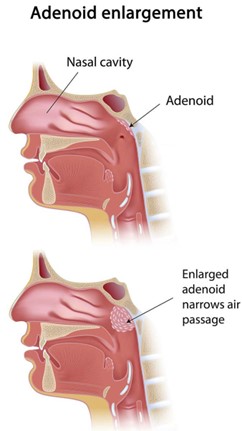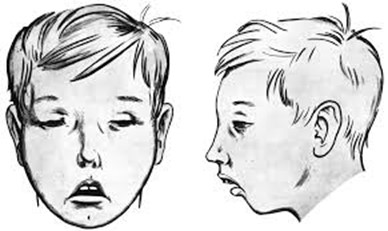MANAGEMENT OF ENLARGED AND INFECTED ADENOIDS
WHAT ARE ADENOIDS?

- The adenoids are lymphatic tissues located at the crossroads of the nasal and oral passages and the throat.
- Individual size variation of the adenoids is common, with changes occurring with age.
- Adenoids typically reach their maximum size between ages 3 and 5.
- They usually shrink during adolescence.
- Adenoids are comprised of specialized cells called lymphocytes, which are involved in filtering bacteria and viruses from the air.
ADENOIDITIS (ADENOID INFECTION)
Adenoiditis is an inflammation of the adenoids. Causes of adenoiditis typically include infections, either viral or bacterial.
SYMPTOMS
Sore Throat
Due to the inflammation of the adenoids.
Stuffy Nose
Swelling of the adenoids can block the nasal passages.
Mouth Breathing
The blockage can force mouth breathing.
Snoring or Sleep Apnea
Blocked air passages may result in snoring and episodes of halted breathing, causing blood oxygen levels to dip below normal.
Ear Problem
Enlarged adenoids block the eustachian tubes, leading to middle ear infections or hearing difficulties.
Bad Breath
Due to the infection and postnasal drip.
Swollen Neck Glands
Reflecting the body’s response to infection.
TREATMENT
Treatment for adenoiditis depends on the severity and the cause. If it’s a bacterial infection, antibiotics may be prescribed. In recurrent or chronic cases, or if the adenoids are causing significant problems like sleep apnea, surgical removal of the adenoids (adenoidectomy) might be recommended.
ADENOID HYPERTROPHY (ENLARGED ADENOIDS)
Adenoid hypertrophy refers to the abnormal enlargement of the adenoids. This condition is more common in children, as the adenoids are typically larger in childhood and tend to shrink with age.
CAUSES OF ADENOID HYPERTROPHY
Chronic Infections
Repeated infections can lead to the enlargement of the adenoids.
Allergic Reactions
Allergies can cause inflammation and swelling of the adenoids.
Immune System Activity
As part of the immune system, the adenoids may enlarge in response to various stimuli.
SYMPTOMS OF ADENOID HYPERTROPHY
Nasal Congestion or Obstruction
Difficulty in breathing through the nose.
Mouth Breathing
Especially noticeable during sleep.
Snoring and Sleep Apnea
Disrupted sleep patterns due to obstructed airways.
Speech Alterations
Nasal-sounding voice due to blocked nasal passages.
Ear Problems
Such as middle ear infections or hearing difficulty, since enlarged adenoids can block the eustachian tubes.
Chronic Sinusitis
Persistent or recurrent sinus infections.
CAN ENLARGED ADENOIDS EFFECT THE WAY MY CHILD LOOKS?

The simple answer is yes. Enlarged adenoids can lead to dental issues, Adenoid Facies, and effect facial growth.
MOUTH BREATHING
Chronic nasal obstruction from enlarged adenoids often forces a child to breathe through their mouth. This can lead to what is referred to as “adenoid facies,” which includes features such as a long face, open mouth, and an undeveloped nose bridge.
DENTAL ISSUES
Over time, mouth breathing can affect the development of the teeth and jaws. It can lead to changes such as an overbite or other dental malocclusions.
FACIAL GROWTH
The chronic mouth breathing associated with enlarged adenoids may influence the normal growth of facial bones, potentially leading to alterations in facial structure.
FACIAL EXPRESSION
Due to chronic nasal congestion and difficulty breathing, a child may often have a tired or listless facial expression.
DIAGNOSTIC PROCEDURES
CLINICAL EXAMINATION
Detailed history-taking focuses on the frequency, duration, and severity of symptoms.
NASOPHARYNGOSCOPY
A flexible endoscope is inserted through the nose to visualize the adenoids directly.
RADIOLOGICAL ASSESSMENT
Lateral neck X-rays or CT scans can offer insights into the size of the adenoids and their impact on the airway.
SLEEP STUDIES
In cases where sleep apnea is suspected, a polysomnogram sleep study might be conducted.
TREATMENT MODALITIES
WATCHFUL WAITING
In mild cases, especially if the child is likely to outgrow the condition.
PHARMACOTHERAPY
- Antibiotics like amoxicillin are often prescribed for bacterial adenoiditis.
- Antihistamines and corticosteroid nasal sprays may be used to reduce inflammation and symptoms.
SURGERY (ADENOIDECTOMY)
Adenoidectomy, the surgical removal of the adenoids, is a well-established procedure with specific indications that warrant its consideration.
- Conducted under general anaesthesia.
- The adenoids are accessed through the open mouth, and specialized instruments are used for their removal.
INDICATIONS FOR ADENOIDECTOMY
Here are the key scenarios where Dr Sandeep Uppal and his team might recommend an adenoidectomy:
CHRONIC OR RECURRENT ADENOIDITIS
- Symptoms: Persistent nasal congestion, runny nose, frequent sinus infections, and ear problems.
- Criteria: When adenoiditis recurs frequently or persists despite appropriate medical treatment, surgical removal is often considered.
RECURRENT NASOPHARYNGEAL INFECTIONS
- Symptoms: Frequent upper respiratory tract infections affecting the nasopharynx.
- Criteria: If the adenoids are deemed to be a focus of infection, their removal can reduce the frequency of these infections.
OBSTRUCTIVE SLEEP APNOEA AND SLEEP DISORDERED BREATHING
- Symptoms: Loud snoring, restless sleep, and daytime sleepiness.
- Criteria: When adenoid hypertrophy is found to be a significant contributing factor to sleep apnea or sleep disordered breathing, an adenoidectomy may be recommended and can have a significant impact on patients’ quality of life.
CHRONIC SINUSITIS OR RHINITIS
- Symptoms: Persistent nasal discharge, facial pain, and post-nasal drip.
- Criteria: When the adenoids are a reservoir for chronic infection that exacerbates sinus issues, their removal is considered.
OTITIS MEDIA WITH EFFUSION (GLUE EAR)
- Symptoms: Hearing loss, frequent ear infections, or persistent fluid in the middle ear.
- Criteria: Adenoidectomy may be recommended in conjunction with myringotomy and tube insertion to resolve recurrent or chronic ear issues.
IMPAIRED NASAL BREATHING
- Symptoms: Difficulty breathing through the nose, leading to chronic mouth breathing and dry mouth.
- Criteria: When enlarged adenoids block the nasal airway, their removal can alleviate symptoms.
FAILURE TO THRIVE IN CHILDREN
- Symptoms: Poor weight gain, reduced activity, and developmental delays.
- Criteria: In rare cases, severe adenoid hypertrophy can contribute to feeding difficulties and poor growth, warranting surgical intervention.
SPEECH AND DENTAL ISSUES
- Symptoms: Nasal-sounding speech or development of dental issues like an overbite.
- Criteria: Adenoidectomy may be considered to correct or prevent speech and dental problems associated with adenoid hypertrophy.
TAKE ACTION AGAINST ADENOID INFECTIONS AND ENLARGEMENT: PROTECT YOUR HEALTH TODAY!
Are you or a family member struggling with persistent nasal congestion, snoring, or ear issues? Adenoid infections and enlargement can cause these symptoms and more, leading to disrupted sleep and discomfort throughout the day.
Adenoid issues, while common in children, can affect individuals of any age. They can lead to complications such as ear infections, sleep apnea, and difficulties with breathing through the nose.
Don’t let adenoid problems go unmanaged. Now is the time to address adenoid infections and enlargement!
Join Us for Better Nasal and Ear Health. Together, we can combat adenoid problems and enhance our well-being. Schedule your consultation with Dr Sandeep for professional advice and treatment options.


